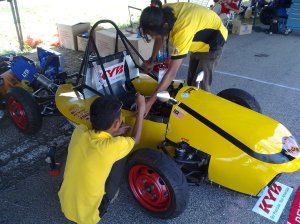Dr. Shamsul Sarip
Electric and hybrid vehicle market has grown rapidly in recent years when the energy crisis hit the world with a market price of oil rising and cost of fuel increases. Vehicle manufacturers geared towards saving energy by introducing an electricity vehicle, as well as a combination of energy sources e.g. bio fuels, hydrogen fuel and electricity, this combination is known as hybrid vehicles. All of these vehicles use electricity as the main source. Electric or hybrid vehicles have braking system specially used to recharge a battery, this system is call regenerative braking. The system is one of the alternative systems as a medium of fuel apart from reducing air pollution.
What is regenerative braking system? Perhaps the number of us never heard that, although the term is still considered new in automotive technology, but this system has long been in existence since the time of the creation of the electric car. Electric vehicles have been created by a Hungarian people in 1828 [1] . Then this vehicle have started to hit the market in 1897 as a public transport introduced by the Electric Carriage and Wagon Company of Philadelphia [2].
The world society is generally not conscious that they have been using the regenerative braking technology long time ago, e.g. a bicycle with a front light which electric source is generated from the generator or dynamo. If you remember back when using the dynamometer on the bicycle, it increase of higher stroke burden, (or accidentally will slow the bicycle) occurs due to the friction between the tires and the bike generator rotor, better known as regenerative braking.
This concept has been used to slow down the vehicle while pressing the brake and the electric motor generator will be activated and will take over the task under normal braking to slow the vehicle.
Advantages of regenerative braking during braking is that it can reduce the use of kinetic energy and transform some of that energy into electricity. The electric energy will be kept to a battery or directly reused to drive the electric motor.
Inspection of the braking system
Kinetic energy into electrical energy
A conventional braking system or without the use of regenerative braking, during deceleration from speed of 110 km/h until stop in 10 seconds will produce a kinetic energy of 730 kJ or produced an average power of 75 kW braking. Similarly, vehicles from speed 32 km/h takes 4.5 seconds for the stop producing kinetic energy of 133 kJ and average braking power of 30 kW. If this process is continuously then the energy will be wasted just like that.
Using regenerative braking, brake energy can be reused to charge the battery. Not all of the energy can be channeled back into the battery, it depends on the power of the motor in the electric vehicle and the factors driving cycle. More frequent vehicle stops the higher braking energy will be regenerated.
Use of electric vehicles in urban areas specifically
A study was done to investigate the use of regenerative braking system and the advantage of this system not only generated electricity but also can save fuel consumption, reduce air pollution and saving rate of the normal braking. Many researchers conducted a study about the influence of driving in a busy area, especially in major cities like Kuala Lumpur certainly frequent use of the brakes, and potentially can be used to generate electric to charge a battery.
The friction load of brake disc will be reduced due to the influence of the regenerative braking system, the design of this system needs to be upgraded so that the system of brake lighter and cheaper. Brake disc design can be improved to accommodate smaller loads during braking. Thus the brake disc design can be sufficient to lower the burden of almost half of the normal braking load.
Regenerative braking system performance
Regenerative braking system performance can be evaluated in terms of the efficiency of the brake torque. Braking torque produced by the motor power itself. Greater power of electric motor the higher motor braking torque can be produced.
The knowledge of this regenerative braking early stage where the torque effectiveness and performance of this system is still small when compared with the existing brake system. This is because the torque from the regenerative braking system cannot accommodate the full braking force during emergency situations where high speed braking torques that exceeding the capacity of regenerative braking system.
The study found that the regenerative braking system can only achieve 40% of the normal braking torque [3]. As such the use of regenerative braking system can only be activated at low speed only, and when you are in an emergency situation is not activated the regenerative braking system or normal braking system will take over. Study on the combination of two normal and regenerative braking methods still needs to be improved so that it can produce a number of high torques braking during emergency [4].
References
[1] A. L. Simon, “Engineering: The Early Years”. Made in Hungary: Hungarian Contributions to Universal Culture,” Simon Publications, p. 246, 1999.
[2] Electric car, 2013.
[3] Sarip, S., Day, A. J., Olley, P., & Qi, H. S. (2013). Analysis of the Transient Thermomechanical Behaviour of a Lightweight Brake Disc for a Regenerative Braking System. In Proceedings of the FISITA 2012 World Automotive Congress (pp. 1075-1088). Springer Berlin Heidelberg.
[4] Sarip, S. “Design Development of Lightweight Disc Brake for Regenerative Braking–Finite Element Analysis.”


